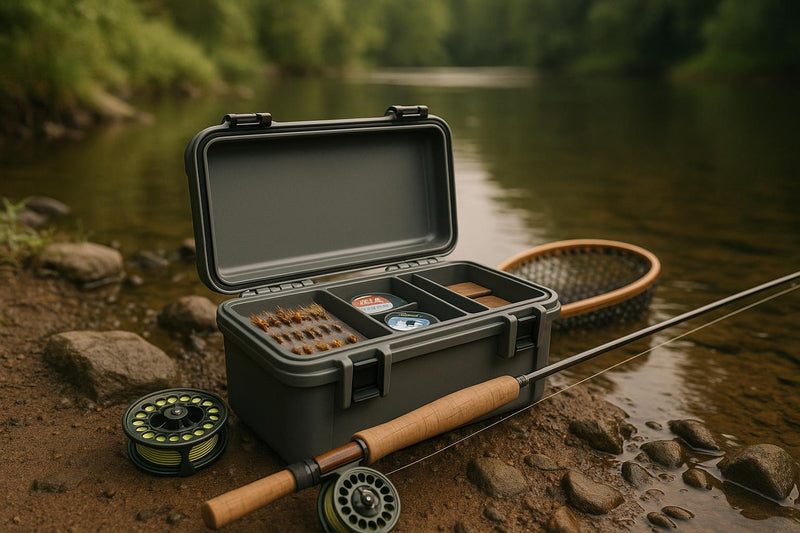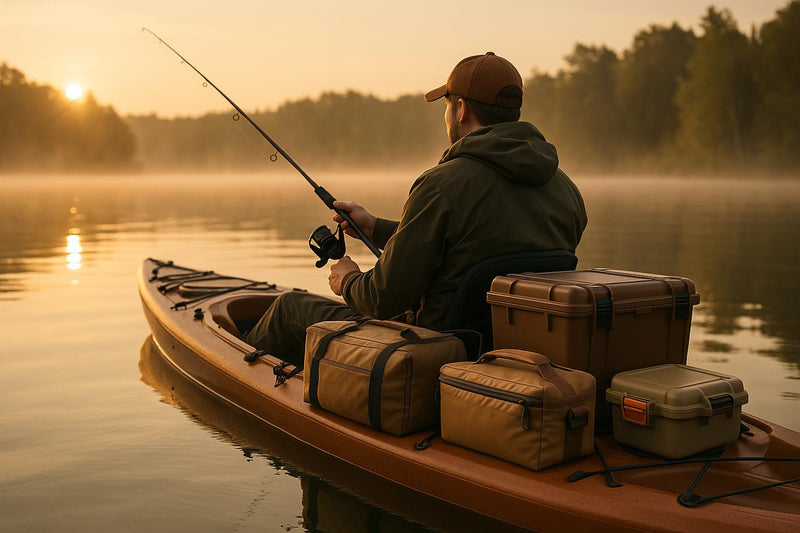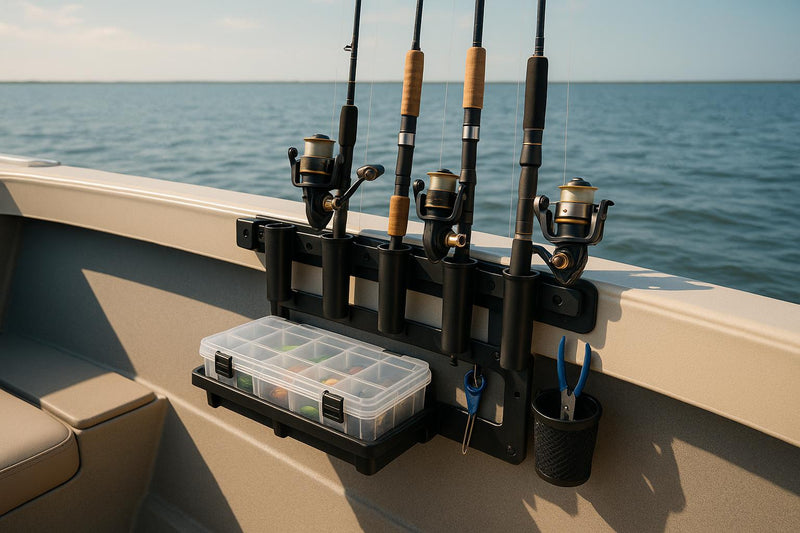If you’re into fishing, the way you care for your gear matters more than you think. Eco-friendly fabric care not only keeps your fishing shorts and other apparel in top condition but also helps reduce pollution in waterways. Here’s what you need to know:
- Wash in Cold Water: Cuts energy use by up to 90% and preserves fabric quality.
- Use Gentle Detergents: Choose eco-friendly options to avoid harming aquatic ecosystems and maintain technical features like water resistance.
- Prevent Microplastic Pollution: Use tools like Guppyfriend bags or Cora Balls to trap synthetic fibers during washing.
- Air Dry When Possible: Protects fabrics from heat damage and extends their lifespan.
- Proper Storage: Keep gear clean, dry, and away from sunlight to avoid mold, fading, and wear.
Fabric Types and Their Care Requirements
Different fabrics require specific care routines to ensure they last longer and have a smaller environmental impact. Your fishing shorts likely combine synthetic and natural fibers, each with its own care needs. Below, you'll find tips for taking care of synthetic fabrics and cotton blends.
Polyester and Nylon Care Tips
Synthetic fabrics like polyester and nylon are popular in fishing apparel for their durability, quick-drying properties, and water resistance. But they need special attention to avoid damage and to help reduce their environmental impact. One major concern with synthetic fabrics is the release of microplastics - these materials contribute to 35% of microplastics in oceans and 71% in rivers.
Start by washing synthetic fabrics in cold water. This not only saves energy but also prevents shrinkage and helps retain colors. Fun fact: heating water accounts for 90% of the energy used in a washing machine. Plus, modern detergents are designed to work effectively in cold water, so it’s an easy switch.
To keep your garments in great shape, turn them inside out before washing, use a gentle cycle to reduce wear, and avoid overloading the machine to prevent unnecessary friction. Stick to mild, eco-friendly detergents, as harsh chemicals can degrade water-resistant coatings and affect performance.
Microplastic pollution can be minimized with a few smart laundry practices. Use a microplastic laundry bag like the Guppyfriend, which captures about 90% of microplastics. Alternatively, consider installing a microfiber filter like PlanetCare on your washing machine, or try adding a Cora Ball to your laundry load - it traps approximately 30% of microfibers.
"If you have sportswear or swimwear made from synthetic fibre – such as recycled polyester or nylon – then we strongly recommend that you use a laundry bag. This will catch the microplastics from the clothes and prevent them from being washed into the oceans."
– SANVT
Air drying is the best option for synthetic fabrics - it saves energy and avoids the high heat that can damage fibers. If you need to use a dryer, stick to low heat and remove items while they’re still slightly damp. For ironing, always use a low-heat setting.
Understanding the differences between polyester and nylon can also help you care for them better. Nylon is stronger and more elastic, making it ideal for high-stress areas like reinforced seams, but it absorbs more water and dries slower. Polyester, on the other hand, dries faster and offers superior water resistance, which is why it’s often featured in quick-dry fabric technology.
Cotton and Cotton Blend Fabrics
Cotton and cotton blends are common in casual fishing apparel and base layers. While not as prevalent in technical fishing gear, knowing how to care for cotton fabrics can help extend their lifespan. Considering that producing just one kilogram of cotton requires over 10,000 liters (approximately 2,640 gallons) of water, proper care is also an eco-friendly choice.
Wash cotton garments only when necessary. For small stains, spot cleaning is a better option than running a full wash. When you do need to wash, use cold water to avoid shrinkage, especially for cotton blends that might include synthetic fibers.
Choose gentle detergents designed for natural fibers, and skip conventional fabric softeners and bleach. Fabric softeners can weaken cotton over time and harm aquatic ecosystems, while chlorine bleach can cause yellowing and damage the fibers. For white cotton, opt for oxygen bleach instead.
To prevent color bleeding and fabric wear, always wash cotton garments with similar colors and turn them inside out. Use a gentle cycle and avoid overloading the machine for better cleaning results.
For stains, act quickly. Treat with cold or warm water, and for tougher spots, apply an eco-friendly detergent to a damp cloth and dab gently - don’t rub aggressively. Natural solutions like white vinegar for sweat stains or baking soda for food and oil spots work wonders.
Air drying is ideal for cotton to prevent shrinkage and fading. If you use a dryer, set it to low heat and remove clothes while they’re slightly damp to reduce wrinkles and avoid over-drying.
| Property | Pure Cotton | Cotton-Polyester Blend | Cotton-Modal Blend |
|---|---|---|---|
| Softness | Very soft | Less soft | Very soft |
| Durability | Low | High | Medium |
| Wrinkle Resistance | Poor | Excellent | Good |
| Breathability | Excellent | Good | Excellent |
| Absorbency | Excellent | Good | Excellent |
| Sustainability | Excellent | Fair | Good |
Store cotton garments in a cool, dry place with proper airflow. Use breathable garment bags for storage and fold heavier cotton items to prevent stretching.
Eco-Friendly Washing Methods
Eco-friendly washing methods not only help protect the environment but also preserve the performance of your gear. By adopting the right washing practices, you can safeguard the waterways you love while ensuring your equipment stays effective for longer.
Cold Water and Gentle Cycles
Switching to cold water is one of the easiest and most impactful ways to reduce energy use. Washing in cold water can cut energy consumption by up to 90%, as heating water accounts for the majority of a washing machine's energy use.
For items like your mens fishing shorts, cold water provides additional benefits. Washing in hot water - above 90°F - can reduce UV protection by 8–12% per wash cycle, meaning a UPF 50 rating could drop to UPF 30 or less after just 10 hot washes. Since UV protection is essential for long hours on the water, sticking to cold water helps maintain this critical feature.
Gentle cycles are equally important for preserving your gear. Using a gentle cycle can reduce microfiber shedding by up to 70%, which means fewer synthetic fibers end up polluting waterways. It also minimizes wear on technical features like water-resistant coatings and moisture-wicking properties. Plus, avoiding overloading your washing machine ensures proper water circulation, leading to better cleaning and less mechanical stress on your gear.
Avoiding Strong Detergents and Chemicals
To protect your gear’s high-performance features, skip harsh chemicals like bleach and fabric softeners. Fabric softeners, for example, can diminish moisture-wicking capabilities by 60–80% after just 5–10 washes, which can significantly impact the performance of technical fabrics.
Instead, opt for eco-friendly detergents specifically designed for activewear and outdoor gear. Look for options that are dye- and fragrance-free, hypoallergenic, and free from harmful ingredients like parabens, SLS/SLES, and phosphates. These formulations help maintain your gear’s features while being gentle on the environment.
Sport-specific detergents are a great choice for fishing gear. For instance, Rockin' Green Platinum Series Active Wear detergent costs about $0.32 per load and features a vegan, biodegradable formula that’s safe for durable water repellent (DWR) finishes. Another option, Sport Suds, priced at $0.62 per load, excels at odor removal and is safe for both greywater and septic systems.
"Our product line was developed by a mom who was fed up with the mis-labeling of supposed 'green' cleaners and frankly, not happy with the performance of other so-called eco-friendly products. Our mission is to create green cleaning products that are hard working to meet the demands of every family, gentle on sensitive skin, AND Earth-friendly." - Rockin' Green
For particularly dirty or smelly items, a pre-soak in an eco-friendly sports detergent can enhance cleaning effectiveness.
Using Laundry Bags
Microplastic pollution is a growing concern, especially for anglers who care about water quality. Microplastic laundry bags, such as the Guppyfriend, can capture about 90% of microplastics released during washing. For those washing their fishing shorts, these bags offer a simple way to reduce environmental impact.
Other solutions include installing a microfiber filter like PlanetCare on your washing machine for long-term protection or using a Cora Ball, which can trap about 30% of microfibers per load.
Using microplastic capture tools doesn’t just protect aquatic ecosystems - it also extends the life of your gear. Laundry bags, for example, reduce fabric agitation, which helps preserve technical materials like quick-dry fabric technology that can be damaged by excessive movement.
Finally, always air out sweat-soaked gear like fishing shorts immediately after use. Leaving them in a pile creates the perfect environment for odor-causing bacteria. This simple habit reduces the need for frequent washing and helps your eco-friendly detergents perform better. Next, discover how proper drying and storage can further extend the life of your gear.
Drying and Storage Best Practices
Taking the right steps to dry and store your gear can significantly extend its lifespan, keeping it water-resistant and free from damage caused by heat, moisture, and UV rays.
Air Drying vs. Machine Drying
Air drying is the best option for maintaining the quality of your fishing shorts. The high heat and tumbling in machine dryers can lead to issues like shrinkage, fading, and stretching, especially with performance fabrics where functionality matters most.
"Air drying can extend the lifespan of your clothes compared to machine drying because it is gentler on fabrics. The absence of heat and mechanical tumbling reduces wear and tear, preventing shrinkage, fading, and stretching." - Aosom
Air drying helps preserve the shape, color, and elasticity of garments by avoiding the stress caused by high heat and mechanical action. For men's fishing shorts made from quick-dry and water-resistant materials, this method ensures their durability and performance remain intact.
To air dry effectively, use hangers, drying racks, or clothespins to evenly space out wet clothing. Make sure there’s enough indoor airflow to prevent mildew and promote proper ventilation. Once dry, give your gear a shake to restore softness.
There is one exception where machine drying can be beneficial. A low or medium tumble-dry setting can reactivate the Durable Water Repellent (DWR) coating on your gear when water stops beading on the fabric.
| Drying Method | Pros | Cons |
|---|---|---|
| Air Drying | - Maintains fabric quality and shape - Reduces shrinkage and fading - Extends garment lifespan |
- Slower process - Weather-dependent outdoors - Requires space for racks - Risk of mildew if not dried properly |
| Machine Drying | - Quick and convenient - Ideal for bulky items - Can reactivate DWR coatings |
- High heat may shrink or fade fabrics - Can weaken fabric integrity - Uses more energy |
Once your gear is completely dry, proper storage becomes the next key step to maintaining its performance.
Proper Storage Methods
After drying, storing your gear the right way is essential to protect its quality. Always store clean, dry items. Rinse your fishing shorts with fresh water after each use to remove salt, dirt, or debris, and ensure they’re fully dry before putting them away. This helps prevent problems like mold, mildew, and odors caused by lingering moisture.
For storage, choose a climate-controlled space and use sealed containers with desiccant packs to keep moisture at bay. This not only protects your gear from mold but also reduces the risk of environmental wear.
Shield your gear from UV exposure by storing it away from direct sunlight. UV rays can weaken fabric fibers over time, fading colors and diminishing the effectiveness of water-resistant coatings.
Fold your fishing shorts carefully to maintain their shape and avoid unnecessary stress on the fabric. For other items like jackets or vests, use sturdy hangers on a garment rack. Adding a dryer sheet to folded shorts or hanging apparel can keep them smelling fresh.
Lastly, inspect your storage area regularly for leaks, excessive humidity, or signs of pests. These small precautions can go a long way in ensuring your fishing shorts stay in top condition. This is especially crucial for padded fishing shorts, as trapped moisture in the padding can cause permanent damage over time.
sbb-itb-cb0a783
Caring for Fishing Shorts
Taking proper care of your fishing shorts is essential to maintain their quick-dry and water-resistant features while also minimizing environmental impact. Premium options, like Reel Comfort's padded fishing shorts, are made with technical fabrics that demand gentle handling. By following these care tips, you can extend the life of your gear and help reduce waste.
Quick-Dry and Water-Resistant Fabric Care
The technical materials used in fishing shorts require a delicate approach when washing. For starters, wash them in cold water - this can cut energy use by up to 90% since heating water accounts for the majority of a wash cycle's energy consumption.
Choose the right detergent. Regular detergents and fabric softeners can leave residues that harm both breathability and waterproofing. Instead, go for plant-based, biodegradable detergents. Options like Sport Suds (dye-free, fragrance-free, and safe for septic systems) or Rockin' Green Platinum Series Active Wear are excellent eco-friendly choices.
"Conventional softeners and detergents can leave residues that affect the breathability and waterproofing. Opt for products that are specially formulated for technical clothing, biodegradable and phosphate-free."
– ECOALF
Avoid fabric softeners. These products can clog the fabric's pores, reducing breathability and water resistance. A better alternative? Add white vinegar to the rinse cycle. It neutralizes odors and dissolves mineral deposits without damaging the material.
To protect the technical coatings, turn your men's fishing shorts inside out before washing. Use a gentle cycle and a mesh laundry bag to reduce friction and limit the shedding of microplastics from synthetic fibers.
Tackle microplastic pollution by using tools like a Guppyfriend washing bag or a Cora Ball, which help capture synthetic fibers before they enter waterways.
If the water no longer beads on your shorts, it might be time to refresh the durable water repellent (DWR) coating. You can reactivate it by applying low heat with an iron (if the care label allows) or using an eco-friendly reproofing spray designed for technical fabrics. For more details, check out our guide on water-resistant gear protection.
Extending the Life of Men's Fishing Shorts
Proper care goes beyond washing. How you use and store your fishing shorts can significantly impact their longevity.
Wash only when necessary. Your men's fishing shorts don’t need to be washed after every trip. Instead, air them out in a shaded, ventilated area to remove odors and moisture. This reduces wear and saves water and energy.
"Every time your clothes go through the washer, they get just a bit more worn down. By choosing to wash less, you're helping maintain the fabric and dyes for longer."
– Better World Apparel
Rotate your shorts. If you have multiple pairs, alternate their use to give each pair time to recover. This simple step can extend their overall lifespan.
Repair small issues. Fix loose threads or small holes right away. For padded fishing shorts, make sure the removable thigh pads are completely dry before storing them to prevent mold and maintain their support.
Protect your shorts during storage by avoiding plastic bags and choosing a dry, ventilated space. Use natural pest repellents like cedar blocks or lavender sachets instead of chemical mothballs.
When your fishing shorts are no longer usable, don’t toss them out. Repurpose them into cleaning rags, gear bags, or donate them to reduce textile waste.
For further insights, explore our article on quick-dry fabric technology, or check out the differences between padded fishing shorts and regular shorts to make informed care decisions.
Conclusion: Eco-Friendly Fabric Care for Anglers
Taking care of your gear in an eco-friendly way not only prolongs its life but also helps protect the fishing waters you cherish. Simple steps like washing in cold water and air drying can make a meaningful difference. Every decision you make about maintaining your fishing shorts contributes to the health of marine ecosystems while keeping your gear in top condition.
"Modern anglers increasingly seek eco-conscious gear choices because they understand that protecting fishing waters today ensures better fishing for future generations." - Fisher Mel, Baitium
Opting for sustainable materials in your gear is a win-win. Recycled fabrics not only improve durability but also reduce waste and safeguard ocean health. For example, your Mens Fishing Shorts can last longer when made from these materials, cutting back on the need for frequent replacements.
This approach doesn’t just benefit the environment - it also saves you money in the long run. Durable, sustainable fabrics mean your fishing shorts stay functional longer, reducing the cost of constant replacements over time.
Your everyday choices have a ripple effect. Washing your gear in cold water, letting it air dry, and using eco-friendly detergents not only extend the life of your clothes but also lower the environmental impact of producing new apparel.
Healthy waterways are essential for the future of fishing, and your fabric care habits play a direct role in preserving them. By incorporating eco-friendly practices, you’re not just taking care of your gear - you’re actively protecting the natural waters that fuel your passion for angling. With better-performing, longer-lasting equipment, you can enjoy your time on the water while contributing to a sustainable future for fishing.
FAQs
Why should I use eco-friendly detergents to care for my fishing shorts?
Using eco-friendly detergents is a smart way to care for your fishing shorts while being kind to the environment. These detergents are biodegradable and free from harsh chemicals, which means they’re gentle on fabrics and help your gear last longer. Plus, by skipping synthetic chemicals, you’re reducing water pollution and protecting aquatic ecosystems.
Another bonus? Eco-friendly detergents typically use less water and energy during production, making them a greener option overall. A simple switch in how you wash your gear can not only keep your fishing shorts in great shape but also contribute to a cleaner, healthier planet.
How can I reduce microplastic pollution when washing synthetic fabrics?
When it comes to cutting down on microplastic pollution from synthetic fabrics, a few easy changes in your laundry routine can make a big difference. Start by washing full loads in cold water. This reduces friction, which helps prevent fibers from breaking loose. Another smart move? Use a microfiber-catching laundry bag or install a washing machine filter - both are great tools for trapping stray fibers before they flow into waterways. You can also try laundry balls or mesh bags specifically designed to capture microplastics. These small adjustments not only help the planet but also keep your clothes in good shape for longer.
Why is air drying better than machine drying for keeping fishing apparel in good condition?
Air drying is a smart way to keep your fishing gear in great shape because it treats fabrics more gently. Unlike machine drying, which can lead to shrinkage or wear down fabric finishes, air drying helps your apparel hold up better over time, so you can count on it for many fishing trips to come.
It’s also a greener choice. Since air drying doesn’t require electricity, it cuts down on energy use and supports the low-impact finishes often found on high-quality fishing shorts. If you care about durability and being environmentally conscious, air drying is the way to go.




